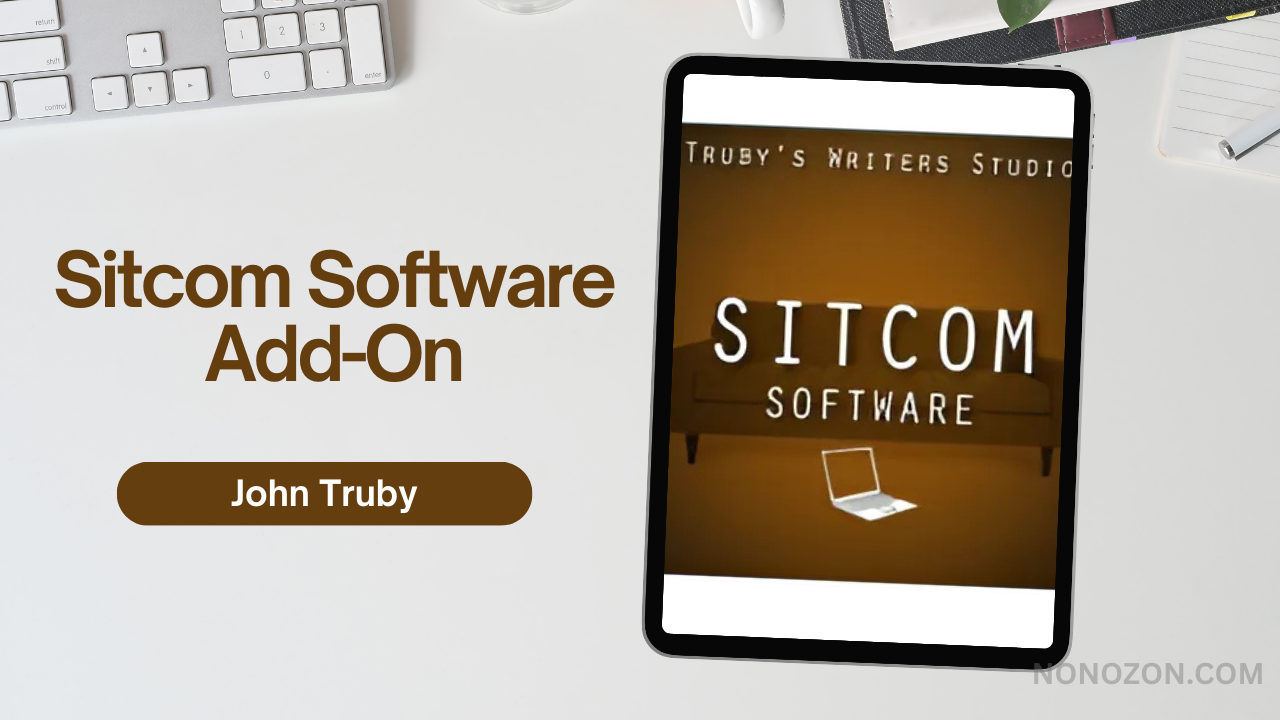Sitcom Software Add-On
by John Truby
In-Depth Review of the Sitcom Software Add-On by John Truby
Check proof of content here:

Crafting humor that resonates with audiences is no easy feat, especially in the sitcom format. John Truby’s Sitcom Software Add-On offers writers a specialized framework to enhance their comedic writing. More than just a tool, this add-on acts as a comprehensive blueprint, guiding writers in creating compelling sitcom scripts. By emphasizing character-driven storytelling and a structured approach to humor, it offers something unique in the world of sitcom writing tools. In this review, we will explore the software’s core features, its strengths and weaknesses, and provide insights into its overall effectiveness in the sitcom writing process.
Key Features of the Sitcom Software Add-On
11 Essential Story Beats
A highlight of Truby’s sitcom software is its inclusion of 11 essential story beats, a framework that helps writers structure their scripts. These beats serve as a blueprint, providing a clear roadmap for navigating the key moments of a sitcom’s comedic journey. Think of it like having a map for a road trip—each beat marks a key destination that ensures the journey remains engaging.
For example, sitcoms like Friends or Parks and Recreation illustrate these beats in their emotional arcs, guiding writers to identify pivotal moments of conflict, resolution, and comedic payoff. The beats are presented in an accessible, straightforward manner, making it easy for both beginners and experienced writers to follow a cohesive structure. This level of organization is akin to preparing a well-balanced meal: the ingredients are organized, the steps are laid out, and the result is a polished, enjoyable script.
Character Types
Another essential component of the Sitcom Add-On is its deep dive into character types. Truby identifies eight core character types commonly found in sitcoms, offering writers a framework to develop characters that resonate with audiences. As characters are the backbone of any sitcom, this insight is crucial for ensuring that each character feels authentic and dynamic.
By understanding these archetypes, writers can think strategically about how characters interact with one another, generating the comedic friction that drives the story. Whether crafting the lovable underdog or the sarcastic sidekick, these character templates ensure that each role adds depth and comedic timing, essential for creating strong narrative dynamics.
Comic Structures and Oppositions
Truby’s software also delves into comic structures and oppositions, providing tools for exploring different setups and payoffs. The software’s A and A/B maps help writers create intricate comedic structures, where setups build anticipation and resolutions deliver satisfying punchlines. This structure is key to successful sitcom writing, allowing for well-timed humor and memorable comedic moments.
Sitcoms like The Office or Brooklyn Nine-Nine have mastered these structures, and Truby’s software equips writers with the tools to craft similarly successful comedic beats. By leveraging these maps, writers can create more engaging and effective comedic moments, distinguishing their work from generic sitcoms.

Learning Resources and Practical Application
Connections to Truby's Sitcom Class
The Sitcom Software Add-On connects directly to Truby’s Sitcom Class, giving users access to professional techniques and valuable examples from beloved sitcoms. This integration offers users the opportunity to refine their skills and deepen their understanding of the subtle nuances of sitcom writing.
Examples drawn from iconic series such as 30 Rock and Seinfeld serve as case studies that allow writers to analyze successful storytelling techniques. By examining these examples, writers can connect theory to practice, better understanding how to engage their audiences through authentic comedic storytelling.
Prompts for Deeper Reflection
A standout feature of the software is its ability to prompt deeper reflection on story structure and character development. Rather than simply providing a blank canvas, Truby’s software encourages writers to think critically about comedic elements early in the process.
This proactive approach helps writers avoid time-consuming rewrites by clarifying their vision from the outset. With thoughtful prompts, the software steers writers away from common pitfalls, making the drafting process smoother and resulting in more polished scripts.
Experiences and User Feedback
Positive Aspects
Overall, users tend to appreciate the Sitcom Software Add-On for its comprehensive approach to sitcom writing. The structured nature of the tool fosters creativity within a clear framework, making it easier for writers to navigate the challenges of creating comedic scripts. Many users have compared the software to having a personal mentor—guiding them through the intricacies of comedic writing.
Positive testimonials often highlight how easy it is to integrate character types and story beats into scripts, resulting in more coherent and engaging stories. Writers who have transitioned from other scriptwriting software have also noticed improvements in their scripts’ structure and comedic timing, further proving the effectiveness of Truby’s methods.
Concerns Regarding User Interface
Despite its many positives, some users have raised concerns about the user interface, noting that it feels outdated compared to modern writing tools. Descriptions of the interface often liken it to software that hasn’t been updated in decades, detracting from the overall experience. Writers who prioritize smooth and intuitive design may find this to be a barrier to creative flow.
Additionally, some users have suggested that the software could benefit from more explicit instructions. Though the features are powerful, a few writers expressed a desire for clearer guidance on how to use the software effectively, especially for those new to sitcom writing.
Conclusion
John Truby’s Sitcom Software Add-On is a valuable resource for writers looking to master the art of sitcom creation. Its structured approach to story beats, emphasis on character-driven narratives, and connections to educational resources offer writers a significant advantage in the sitcom writing process. While its outdated interface and the lack of comprehensive instructions may pose challenges, the insights and frameworks it provides more than make up for these shortcomings. By using this software, writers are not only empowered to craft better scripts but also gain a deeper understanding of how to structure their stories for maximum comedic effect.
Related products

Renaissance Man: Ultimate Writer X: Unlimited Creativity for Profound Transformative Written Expression
by Subliminal Club
$34.00
$15.40



